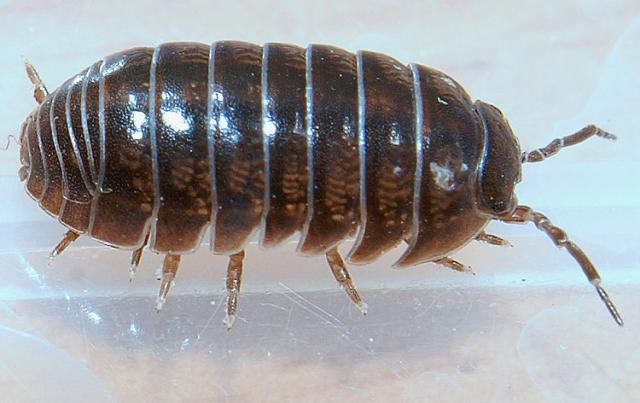Scientific classification:
Kingdom: Animalia
Phylum: Arthropoda
Class: Crustacea
Order: Isopoda
Family: Armadillidiidae
Genus: Armadillidium
Species: vulgare
Habitat:
The native distribution of A. vulgare ranges across Europe, especially in the Mediterranean region . In the United Kingdom, A. vulgare is very common in southern and eastern England, but is more confined to coastal areas in the north. Similarly, in Ireland, A. vulgare is common in the south and east, but rarer in the north and west.
A.vulgare has been introduced to many locations in North America, where it may reach population densities of up to 10,000 individuals per square metre. It is now one of the most abundant invertebrate species in California coastal grassland habitats. It has also been introduced, to a lesser extent, to sites across the world.
Occurs only on calcareous soils, except in coastal areas , and is able to withstand much drier conditions than most other woodlice . It shows a distinct preference for chalky or limestone sites with stony turf
Identification:
May reach a length of 18 millimetres (0.71 in), and is capable of rolling into a ball when disturbed; this ability, along with its general appearance, gives it the name pill-bug and also creates the potential for confusion with pill millipedes such as Glomeris marginata.Their light shell-like crustaceous exterior is usually a drab earthy color. Pill bugs found in North America range from gray to brown. However, those with habitats in Europe have large red dots, which give them protection by conferring a resemblance to black widow spiders. Pill bugs have five abdominal segments which are distinct dorsally. Their first antennae are vestigial.
Nutrition:
A. vulgare, like most isopods, are omnivorous. They feed on fungi, live or dead plants and animals. Special treats for pill bugs are monocotyledonous leaves. All isopods increase decomposition by processing leaves through their alimentary canal. It is not uncommon for pill bugs to shift from one type of food to another, for during a drought they turn from being vegetarians into scavengers.
Reproduction:
A. vulgare reproduce on land as opposed to in water. Eggs develop in a brood pouch filled with fluid, from which fully developed young are released. They produce between one and two broods. The number produced depends on the size and condition of the female, who may cease to grow under stress due to excessive hydration, which reduces the chance of a second reproduction. Ironically, when the food supply is short, the offspring grow larger.
Role in the ecosystem:
These animals are part of the community of species that break down dead plants and animals. Pill bugs living in gardens help circulate soil, although they may also eat small plants.
Curiosity:
They are famous for curling up into a tight ball for a defense mechanism. Some may secrete a substance which discourages spiders. The most common defense among all of them is to remain inconspicuous. They have a life span of up to five years!
It is able to regulate its temperature through its behaviour, preferring bright sunshine when temperatures are low, but remaining in shadow when temperatures are high; temperatures below −2 °C (28 °F) or above 36 °C (97 °F) are lethal to it. A. Vulgare is less susceptible to cold during the night, and may enter a state of dormancy during the winter in order to survive temperatures which would otherwise be lethal.
